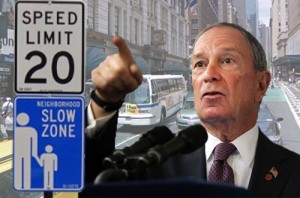Mayor Announces “Slow Zones” to Increase Road Safety, Reduce Accidents

Mayor Michael R. Bloomberg announced alongside the DOT Commissioner Janette Sadik-Khan that the City’s Neighborhood Slow Zones would be expanded—increasing the areas where the speed limit is dropped in order to prevent accidents and increase safety.
According to a press release from the city of New York, the Slow Zone program reduces speed limits from 30 miles per hour to 20 miles per hour in targeted residential areas. This, they say, has played a role in decreasing the number of fatal accidents in the city, and they hope an expansion can bring even further reductions.
In 2011, traffic fatalities in the city were at the lowest levels ever in recorded history. That is significant. The last four years have been the safest overall in regards to accidents.
The zones targeted for the Slow Zone program were identified by citizens themselves. They were requested by residents and then were evaluated for “crash history, community support, proximity of schools, senior centers, and daycare centers,” according to the city’s press release. Now those areas are in the design and approval process before the speed limit changes will be made official.
“We’ve driven fatalities and injuries down to record lows through innovative traffic engineering, aggressive enforcement and an unwavering commitment to finding new ways to make our streets safer, as even one fatality is too many,” said Mayor Bloomberg. “We are continuing our assault on the number one traffic killer: speeding. We’ve seen success already where we have installed Slow Zones and we expect safety will improve as speeding is reduced in these communities.”
The 13 areas being targeted with the expansion include: Mt. Eden, Baychester, Eastchester, and Roverdale in the Bronx; Inwood in Northern Manhattan; Boerum Hill in Brooklyn; New Brighton/St. George, Dongan Hills and Rosebank on Staten Island; and Corona, Elmhurst, Jackson Heights/East Elmhurst and Auburndale in Queens.
The areas in the Slow Zone program don’t only have lower posted speed limits, but are also outfitted with speed bumps and the streets are marked with eight foot long signage that says 20 mph. In those that were installed when the program first began two years ago, speeds have been reduced by about 10 percent.
Speed is a contributing factor in many serious car accidents. By reducing speed limits, the city is showing a dedication to the safety of New Yorkers. Sure, the speed bumps might be an inconvenience, but the alternative could dramatically change your life.
If you are involved in an accident involving another driver who was speeding, your injuries aren’t the only things causing you pain. Holding the other driver responsible for the results of the accident can provide a sense of justice.